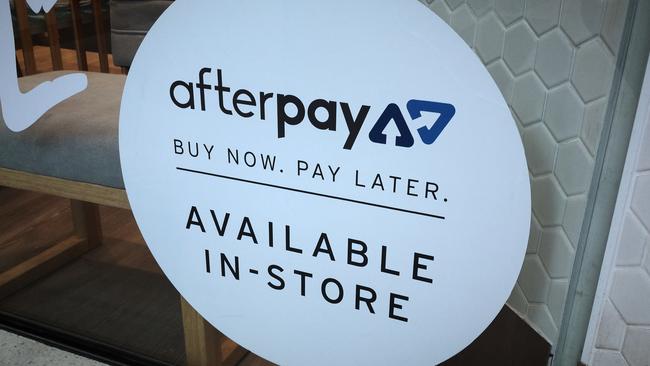A new world of banking emerges
Afterpay’s “banking as a service” deal with Westpac raises a number of fundamental questions, some of them existential.

Afterpay’s “banking as a service” deal with Westpac raises a number of fundamental questions, some of them existential.
While Afterpay becomes Westpac’s first dance partner on its new digital banking platform, the payments disrupter will go stir-crazy at any suggestion that its 3.3 million-plus active users in Australia and New Zealand are set to become Westpac customers.
They are Afterpay customers and always will be. And they will continue to get the full Afterpay “experience”, even if they extend the relationship to a savings account and associated budgeting tools.
Westpac, for its part, is almost an invisible partner, providing the infrastructure in the form of the digital platform, the banking licence, and the extra layer of comfort from the industry’s deposit guarantee.
It also benefits from increased exposure to the 18 to 35-year-old demographic, with the funds accumulating in the Afterpay savings accounts from the second quarter of 2021 appearing on Westpac balance sheet.
This was one of the main attractions of the deal for the big-four bank.
The existential question relates to the identity of the long-term winner from this uneasy coexistence between fintechs and legacy banks.
Once Afterpay introduces savings accounts and budgeting tools, it gets a much more complete and valuable picture of its customers, hopefully improving retention rates and lifting their transaction frequency.
Algorithms will spit out customer data which can be used to lure more merchants to the platform or cross-sell new products.
Provided there’s no dilution of the Afterpay brand, real or otherwise, there’s gains to be realised by the buy now, pay later group.
But it’s not all one-way traffic.
Commonwealth Bank was highlighted in an article in The Economist this month as an example of a bank more suited to the world of new technology than others. The CommBank app earned praise for offering “Netflix-like personalised service”, such as notifying users when bills were due and advising them on tax returns.
While Westpac’s long-term targets for its digital platform are unclear, the bank clearly has an appetite for more Afterpay-type deals.
Chief executive Peter King on Tuesday said the platform allowed the bank to combine its banking experience with the “innovation of its partners to support new customer experiences”.
The existential threat emerges when legacy players are restricted to a low-value infrastructure contribution in the value chain by surrendering high-returning niches to nimble tech players with dizzy customer satisfaction ratings.
According to management consultancy McKinsey, highly regulated and capital intensive core banking activities such as running a balance sheet make $US3 trillion ($4.3 trillion) in revenue with a return on equity of 5-6 per cent.
Fintechs, however, are only after the tasty bits of the pie, such as payments and product distribution which yield $US2.5 trillion in sales but offer highly attractive ROEs of about 20 per cent.
The problem for the fintechs is they need the banks to survive.
Molopo stung
When former Reserve Bank director Roger Corbett became the seventh Molopo Energy chairman in as many years, he fanned hopes that the newly impoverished cashbox would claw back some of the $US35m ($49.4m) splashed by his predecessors on a disastrous US oil play.
How’s that gone, now that two years have passed? The short answer is things just got worse.
Last Friday at the ungodly hour of 6.12pm, when some companies are gripped by an inexplicable urge to put out their rubbish, Molopo released a succinct, one-paragraph announcement, revealing it had fallen victim to an email scam involving a misdirected payment of $670,800.
The announcement was authorised by Corbett. The sorry story began when Molopo initiated the payment through its bank to a “well-known creditor”.
The funds, however, were misdirected to a third-party account due to an email from the creditor which appeared to be genuine but on further investigation was “suspected” of being fraudulent.
“The company is attempting to trace the fictitious email and banking details and will take whatever action is necessary to recover these funds,” Molopo said.
“The board will advise further when information is available.”
When Corbett became Molopo chairman in June 2018, several allies including former ASIC chairman Tony Hartnell joined him, replacing the incumbents.
The focus of the new board was retrieving value from Molopo’s wealth-draining acquisition of Orient Energy in the US, which was undertaken without shareholder approval.
Corbett said at the time he was determined to stand up for the company’s long-suffering smaller investors.
“We will be doing our best to ensure we can secure as much remaining value as possible for our shareholders,” he said.
“I’m aware there are 4000 small shareholders, I have accepted nomination to the board and I have accepted nomination to the position of chairman, and I feel a deep responsibility to do whatever I can to get shareholders some value for their investment.”
A long-term shareholder himself, Corbett noted that the newly installed directors either held shares in the company, or had been nominated by existing Molopo shareholders.
In contrast, the previous board did not hold Molopo shares.
At the annual meeting last May, Corbett said directors believed that litigation against their predecessors was the only option to recover any value.
On the upside, the email scam presents a further opportunity for the board to enhance its recovery skills.
gluyasr@theaustralian.com.au Twitter: @Gluyasr


